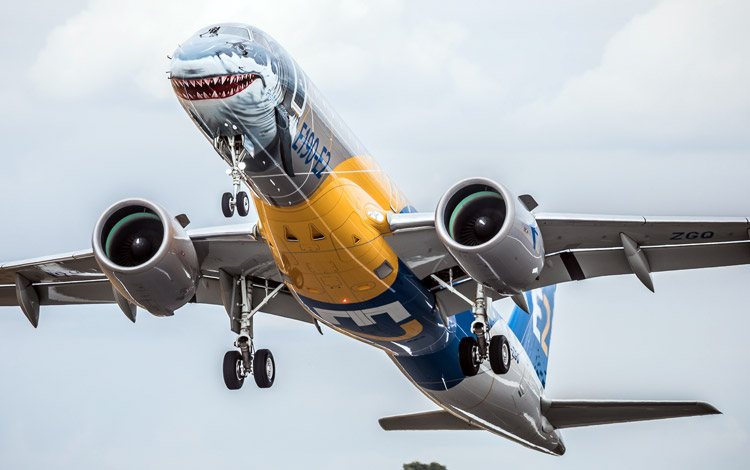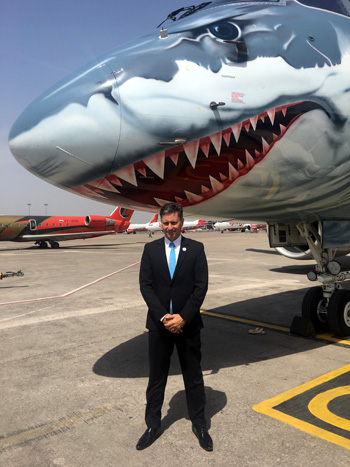Break even by selling just 50 seats per trip: Embraer's proposition to bleeding Indian carriers
Brazilian manufacturer hard sells its smaller regional jets as the turnaround solution for low cost carriers & mascots for the Udan regional connectivity scheme

Brazilian aircraft manufacturer Embraer has proposed "right sizing" of aircraft to stop Indian carriers from bleeding under the pressure of unviably low fares.
It is hard selling the induction of regional jets with a passenger capacity between 70 to 150 in the fleet mix of struggling Indian carriers.

The sales pitch is persuasive: While the narrow-body Boeing 737 and Airbus 320 - the mainstay of Indian carriers - need to sell at least 120 seats per trip to break even, the smaller regional jets which incorporate all the advantages of the narrow-body jets need to sell just 50 per trip, while providing range flexibility up to 5,300 km. The Boeing and Airbus fleets offer passenger capacity of close to 200.
"The E190-E2 offers airlines the benefit of operating costs which are 20-to-25 per cent lower per trip as compared to an Airbus 320. Its per seat cost is less by 5 -to-10 per cent," says Embraer's Cesar Pereira
Fares have been pushed down below levels which make business sense due to the intense competition to sell the excess seat capacity created by the bigger, narrow-body jets. Reduction of excess capacity through "right-sized" aircraft will ease the fare wars.
Embraer presented its new E190-E2 regional jet to the Indian market at a pit stop in New Delhi on March 20 as part of a promotional tour of the region. SP's Aviation was among the handful of media houses to be invited for a preview. Sporting s shark livery on its nose to pitch the aircraft as a 'Profit Hunter', the E190-E2 was being promoted as "the world's quietest, cleanest and most efficient new-generation single-aisle aircraft".
"Copying the Indigo model has reduced the per seat margins of Indian carriers to less than what Starbucks makes by selling one coffee."
"Our Hunter is built to create opportunities for maximum profit at low risk," said Cesar Pereira, Embraer's Vice-President Asia Pacific. "The E190-E2 offers airlines the benefit of operating costs which are 20-to-25 per cent lower per trip as compared to an Airbus 320. Its per seat cost is less by 5 -to-10 per cent," claimed Pereira in an exclusive interview to SP's Aviation. In different configurations, this regional jet can have 104 or 114 seats.
"Operating this aircraft would significantly reduce the cash outgo of airlines. At 60 per cent of the cost of a narrow-body aircraft, it is significantly cheaper, which will reflect in reduced costs or lease money. Its 17.3 per cent fuel burn reduction means lower fuel costs. And it's lighter weight means lower airport, which is charged on the weight of the aircraft," he explained. "It's a reliable aircraft which can be flown 7-to-8 times a day, with maintenance turnaround needed after 10,000 hours," Pereira said.
"The E-Jets E2's value proposition in the Asia Pacific region is its ability to enable airlines to sustainably develop more routes secondary or tertiary cities. These are routes that can potentially bypass the major metro airports such as Manila, Jakarta, Bangkok, New Delhi and Mumbai which are heavily congested."
The Embraer honcho linked the lack of profitability in the Indian civil aviation market to the unsuccessful attempt by rival carriers to imitate the Indigo model, which is built around narrow-body jets. "Indigo has a unique business model which has efficiencies built into it. Its cost base cannot be matched by others. Competitors are losing money trying to do the same thing. In the process, they're reducing the quality of revenue. If there are lesser seats to be sold than in narrow body jets, airlines wouldn't need to reduce costs. Copying the Indigo model has reduced the per seat margins of Indian carriers to less than what Starbucks makes by selling one coffee," he said.

The E2 jets are also being pitched as route openers for low cost carriers which could also mesh into India's Udan regional connectivity scheme. "The E-Jets E2's value proposition in the Asia Pacific region is its ability to enable airlines to sustainably develop more routes secondary or tertiary cities. These are routes that can potentially bypass the major metro airports such as Manila, Jakarta, Bangkok, New Delhi and Mumbai which are heavily congested. This enables airlines to achieve sustainable growth without being constrained by infrastructure bottlenecks, while offering passengers improved services with more non-stop flights," explained Pereira.
"The first stage of schemes like Udan across the world is to get people to fly. The second stage is to provide secondary or tertiary cities direct, non-stop flights to more destinations over longer ranges. This is where the a regional jet will provide flexibility of options while ensuring commercial viability," he said.
Pereira estimates the market for regional jets in India to be 300 over 20 years. Embraer forecasts a demand for 10,550 new aircraft with up to 150 seats worldwide, worth USD 600 billion, over the next 20 years, more than 3,000 of which will origin from the Asia Pacific region, including China. The Brazilian company is a global leader in sales of aircraft in the 70-to-150 seat capacity. It's share of the market is 29 per cent. Over 1,700 of its jets are in operation with 111 airlines across 60 countries.
With its regional jets, Embraer is attempting to snatch business space from both the narrow body segment dominated by the Boeing 737 and Airbus 320 as well as the turboprop market. "We got 207 orders for our jets last year. Against this, the total backlog of orders of ATR is 208," Pereira said, emphasising higher versatility of jets versus the turboprops.





